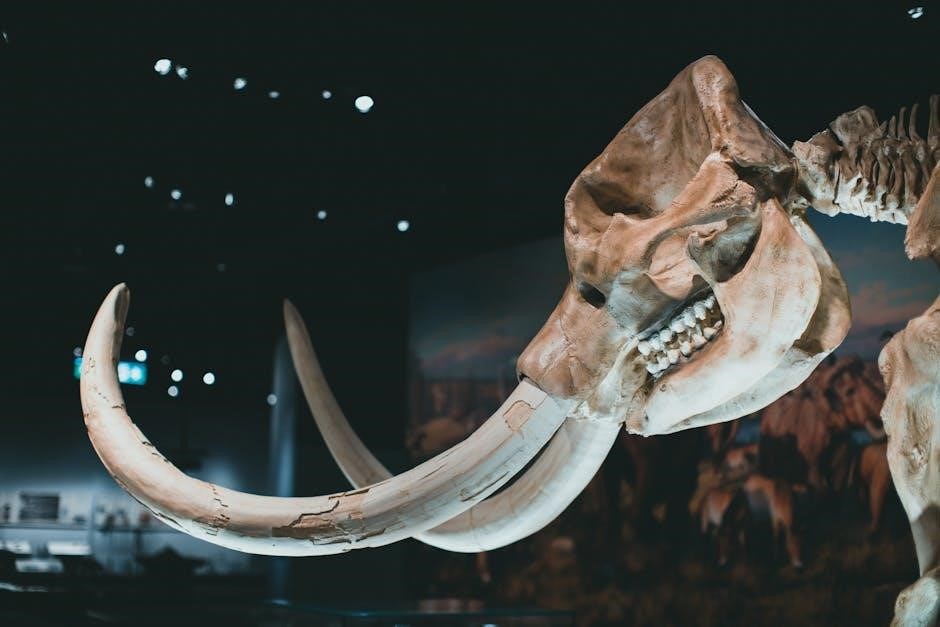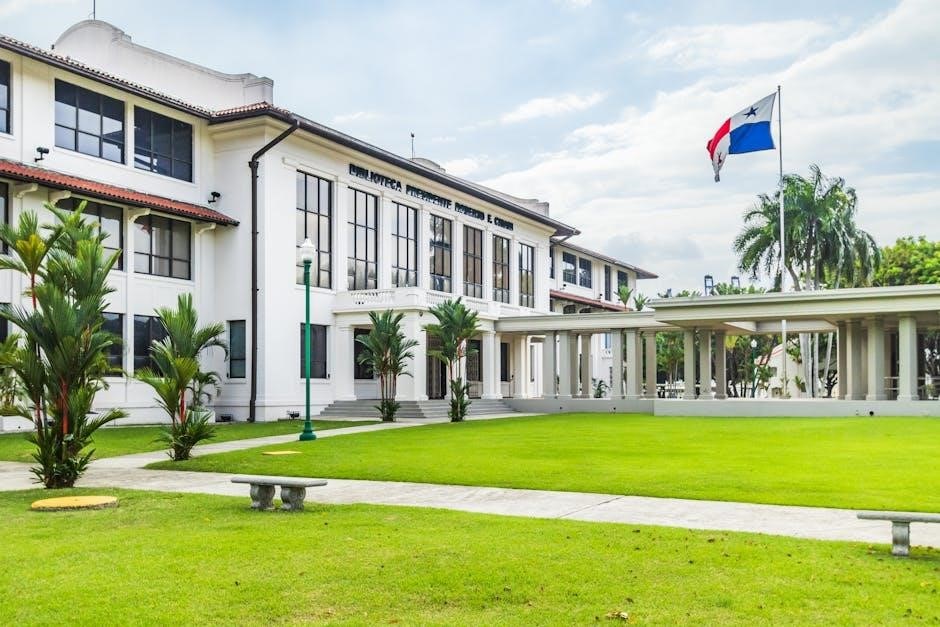This guide provides a comprehensive overview of key events‚ figures‚ and concepts in American history‚ preparing students for the EOC exam with structured resources and strategies.
1.1. Understanding the Importance of the EOC Exam
The EOC exam assesses students’ understanding of U.S. History‚ covering significant events‚ trends‚ and figures. It evaluates critical thinking and analysis skills‚ reflecting a student’s grasp of historical principles and their impact on governance. A strong performance is crucial for academic success and meeting state standards.
1.2. Overview of Key Historical Periods Covered
The EOC exam spans U.S. History from early settlers to contemporary times‚ including the Colonial Era‚ American Revolution‚ Civil War‚ Reconstruction‚ Gilded Age‚ World Wars‚ Great Depression‚ Cold War‚ Civil Rights Movement‚ and modern America. Understanding these periods is essential for exam success and historical comprehension.
Major Periods in American History
Explore pivotal eras‚ including the Colonial Era‚ American Revolution‚ Civil War‚ Reconstruction‚ Industrialization‚ World Wars‚ Great Depression‚ Cold War‚ and contemporary America.
2.1. Colonial Era and the American Revolution
The Colonial Era began with European exploration and colonization‚ leading to the development of distinct cultural and political systems. Tensions over taxation and governance sparked the American Revolution‚ culminating in the Declaration of Independence in 1776. Key figures like George Washington and Thomas Jefferson played pivotal roles in shaping the nation’s foundation.
2.2. The Civil War and Reconstruction
The Civil War (1861–1865) was fought over slavery and states’ rights‚ resulting in the abolition of slavery via the Emancipation Proclamation and the 13th Amendment. Reconstruction aimed to integrate freed slaves into society‚ but faced resistance‚ leading to Jim Crow laws and ongoing racial tensions despite significant social and political changes.
2.3. The Gilded Age and Industrialization
The Gilded Age (1870-1900) saw rapid industrialization‚ technological advancements‚ and massive wealth disparity. Industrial titans like Carnegie and Rockefeller dominated‚ while workers faced harsh conditions. This era marked the rise of big businesses‚ urbanization‚ and labor movements‚ shaping America’s economic and social landscape during its transition to a modern industrial power.
2.4. World War I and the Roaring Twenties
World War I marked the U.S. emergence as a global power‚ with significant contributions and losses. The Roaring Twenties brought cultural transformation‚ jazz‚ and flappers‚ alongside Prohibition. This era also saw economic prosperity‚ technological advancements‚ and social change‚ but underlying tensions foreshadowed future conflicts and the Great Depression.
2.5. The Great Depression and World War II
The Great Depression brought economic devastation‚ widespread unemployment‚ and social unrest‚ prompting President Franklin D. Roosevelt’s New Deal. World War II saw the U.S. emerge as a global superpower after Pearl Harbor‚ contributing significantly to the Allied victory. The war’s end marked the beginning of a new world order.
2.6. The Cold War and Civil Rights Movement
The Cold War marked decades of tension between the U.S. and Soviet Union‚ shaping global politics and American society. Simultaneously‚ the Civil Rights Movement fought for racial equality‚ culminating in landmark legislation like the Civil Rights Act of 1964‚ forever altering the nation’s social fabric and ideals of freedom.
2.7. Contemporary America (1970s to 2001)
From the 1970s to 2001‚ America experienced significant social‚ political‚ and economic changes. The Vietnam War ended‚ the Civil Rights Movement continued‚ and technological advancements transformed society. Globalization and the rise of the internet reshaped the economy. Events like the Gulf War and the 9/11 attacks marked the nation’s evolving role in global affairs.

Key Documents and Concepts
Explore foundational documents like the Declaration of Independence‚ Constitution‚ and Bill of Rights‚ alongside pivotal acts such as the Emancipation Proclamation and Civil Rights Act of 1964.
3.1. The Declaration of Independence
The Declaration of Independence‚ adopted in 1776‚ formally declared the 13 colonies’ independence from Britain. It established the principles of equality‚ liberty‚ and democracy‚ shaping America’s foundational values and inspiring future governance documents like the Constitution.
3.2. The Constitution and Bill of Rights
The Constitution‚ ratified in 1788‚ established the framework of the U.S. government. The Bill of Rights‚ added in 1791‚ guaranteed fundamental freedoms such as speech‚ religion‚ and the right to bear arms‚ ensuring individual liberties and limiting government power.

3.3. The Emancipation Proclamation
Issued by President Abraham Lincoln in 1863‚ the Emancipation Proclamation declared freedom for enslaved individuals in Confederate states. It paved the way for the 13th Amendment‚ abolishing slavery‚ and marked a turning point in the Civil War‚ shifting focus toward ending slavery and preserving the Union.
3.4. The New Deal and Its Impact
The New Deal‚ implemented by President Franklin D. Roosevelt‚ aimed to alleviate the Great Depression through economic reforms and social programs. Major initiatives included the Works Progress Administration and the Civilian Conservation Corps. It stabilized the economy‚ provided relief to millions‚ and introduced long-term reforms like the FDIC and Social Security.
3.5. The Civil Rights Act of 1964
The Civil Rights Act of 1964 was a pivotal law that outlawed discrimination based on race‚ color‚ religion‚ sex‚ or national origin. It ended segregation in public spaces and mandated federal enforcement for desegregation in schools and workplaces‚ significantly advancing equality and shaping civil rights in America.

Significant Events and Their Implications
This section explores pivotal moments in American history‚ analyzing their immediate and long-term impacts on societal development‚ governance‚ and cultural evolution‚ shaping the nation’s trajectory.
4.1. The Louisiana Purchase and Manifest Destiny

The Louisiana Purchase of 1803 doubled U.S. territory‚ sparking westward expansion and embodying Manifest Destiny‚ the belief in America’s divine right to expand across North America‚ shaping national identity and future growth.
4.2. The Industrial Revolution’s Impact on Society
The Industrial Revolution transformed America’s economy and society‚ fostering urbanization‚ technological advancements‚ and mass production. It created new job opportunities but also led to labor exploitation‚ wealth inequality‚ and environmental challenges‚ reshaping the nation’s social and economic fabric.
4.3. The Stock Market Crash of 1929
The Stock Market Crash of 1929 marked the onset of the Great Depression‚ as stock prices plummeted‚ wiping out millions of dollars in investments. This event triggered widespread economic panic‚ leading to a sharp decline in consumer spending and industrial production‚ ultimately causing massive unemployment and financial ruin for many Americans.
4.4. The Pearl Harbor Attack and U.S. Entry into WWII
The Pearl Harbor attack occurred on December 7‚ 1941‚ when Japan launched a surprise assault on the U.S. naval base in Hawaii. This act led to the United States declaring war on Japan‚ with Germany and Italy subsequently declaring war on the U.S.‚ fully engaging America in World War II.
4.5. The September 11 Attacks and Their Aftermath
The September 11 attacks occurred in 2001‚ when terrorists hijacked planes and targeted the World Trade Center and Pentagon. This event led to the War on Terror‚ the Patriot Act‚ and a significant shift in U.S. foreign policy and national security measures‚ impacting global relations and civil liberties.
Important Figures in American History
Key figures like George Washington‚ Abraham Lincoln‚ and Martin Luther King Jr. shaped America’s history through leadership‚ reforms‚ and advocacy‚ influencing the nation’s development and identity.
5.1. Founding Fathers: George Washington‚ Thomas Jefferson‚ Benjamin Franklin
The Founding Fathers‚ including George Washington‚ Thomas Jefferson‚ and Benjamin Franklin‚ played pivotal roles in shaping America. Washington led the Revolution and became the first president‚ Jefferson drafted the Declaration of Independence‚ and Franklin contributed to diplomacy‚ science‚ and the Constitution‚ leaving lasting legacies in American history and governance.
5.2. Abraham Lincoln and His Leadership During the Civil War
Abraham Lincoln’s leadership during the Civil War was pivotal in preserving the Union. As president‚ he issued the Emancipation Proclamation‚ paving the way for the abolition of slavery. His Gettysburg Address reinforced the principles of equality and unity. Lincoln’s assassination in 1865 deeply impacted the nation‚ cementing his legacy as a unifying figure.
5.3. The Role of Martin Luther King Jr. in the Civil Rights Movement
Martin Luther King Jr. was a central figure in the Civil Rights Movement‚ advocating for racial equality through nonviolent protest. His leadership in events like the March on Washington and the “I Have a Dream” speech helped galvanize support for landmark legislation such as the Civil Rights Act of 1964.
5.4. Franklin D. Roosevelt and His New Deal Policies
Franklin D. Roosevelt’s New Deal addressed the Great Depression with programs like the Civilian Conservation Corps and Works Progress Administration‚ providing relief and stimulating economic recovery. His policies reformed financial systems and redefined the role of government in addressing societal challenges‚ leaving a lasting impact on American governance and economy.
5.5. Ronald Reagan and the End of the Cold War
Ronald Reagan’s leadership played a pivotal role in ending the Cold War. His policies‚ including the Strategic Defense Initiative and diplomatic engagement with Mikhail Gorbachev‚ pressured the Soviet Union. The Intermediate-Range Nuclear Forces Treaty and Gorbachev’s reforms hastened the collapse of communism‚ marking the end of the Cold War era.

Study Strategies for Success
Effective strategies include active recall‚ creating study schedules‚ and explaining concepts to others. These methods enhance retention and understanding‚ ensuring thorough preparation for the EOC exam.
6.1. Effective Note-Taking Techniques
Use the Cornell Method for organized notes‚ review them within 24 hours‚ and summarize key points. Highlight essential terms and concepts‚ creating a concise study resource that aligns with exam topics for efficient revision and understanding of historical events and ideas.
6.2. Utilizing Flashcards for Key Terms
Create flashcards with key historical terms on one side and definitions or explanations on the other. Use digital tools like Quizlet or physical cards to memorize concepts. Regularly review and test yourself to reinforce memory‚ focusing on terms like the Gilded Age‚ Industrial Revolution‚ and significant events.

6.3. Practicing with Past EOC Exams
Practicing with past EOC exams helps familiarize yourself with the test format and content. Use released tests to simulate exam conditions‚ identify strengths and weaknesses‚ and refine time management. Analyze answers to understand common question types and improve your performance effectively.
6.4. Time Management During the Exam
Effective time management is crucial for success. Skim the entire exam first to assess content‚ then allocate specific time per question. Answer easier questions first to secure early points‚ leaving time to tackle challenging ones. Review answers briefly to avoid mistakes. Avoid random guessing to prevent penalties‚ enhancing overall performance.
6.5. Staying Calm and Focused
Staying calm and focused during the exam is vital for optimal performance. Take deep breaths‚ read questions carefully‚ and avoid rushing. Maintain a positive mindset to reduce anxiety. Minimize distractions by staying organized and confident in your preparation. A clear mind ensures better comprehension and decision-making‚ leading to improved results.
Additional Resources for Preparation
Utilize online resources‚ recommended textbooks‚ and study guides to enhance your preparation. Join study groups‚ use digital tools‚ and seek guidance from teachers for comprehensive exam readiness.
7.1. Recommended Textbooks and Study Guides
Enhance your preparation with textbooks like The American Pageant and A People’s History of the United States. Utilize study guides such as CliffsNotes and SparkNotes for concise summaries. Digital tools like interactive textbooks and historical document collections also provide valuable insights for exam success.
7.2. Online Resources and Practice Tests
Leverage online platforms like Khan Academy and Quizlet for interactive lessons and flashcards. Utilize official EOC practice tests and websites offering historical overviews‚ digital lectures‚ and past exam questions to refine your understanding and test-taking skills effectively.
7.3. Joining Study Groups or Hiring a Tutor
Collaborate with peers in study groups to share insights and stay motivated. Consider hiring a tutor for personalized guidance‚ addressing weak areas‚ and gaining deeper understanding. These strategies complement online resources‚ ensuring well-rounded preparation for the EOC exam.
7.4. Using Digital Tools for Interactive Learning

Leverage digital tools like interactive timelines‚ educational apps‚ and online simulations to engage with historical content dynamically. Platforms such as Kahoot! and Quizlet offer gamified learning experiences‚ while virtual field trips and multimedia resources enhance understanding and retention of key historical events and concepts.
7.5. Seeking Guidance from Teachers

Teachers offer valuable insights and personalized support‚ helping students address weaknesses and clarify doubts. Regular consultations ensure a deeper understanding of complex topics‚ while tailored study strategies and feedback enhance preparation‚ enabling students to approach the EOC exam with confidence and a well-rounded grasp of the material.
